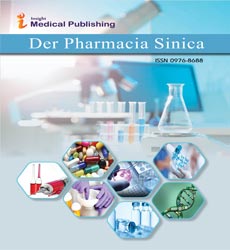ISSN : 0976 - 8688
Der Pharmacia Sinica
Study to explore inclusion complexes of a sulfa drug with cyclic oligosaccharide molecules for advanced applications
Abstract
Molecular encapsulation is extremely important in pharmaceutical and drug delivery science. Here, one of the most important sulfa drugs, namely, sulfacetamide sodium, has been probed in the solution and solid phases for encapsulation within the cavities of α- and β-cyclodextrins. This phenomenon of drug inclusion is exceedingly significant for its stabilization against external hazards, such as oxidation, sensitization, and photolytic cleavage, for the proficient and accurate regulatory release of an essential amount of drug at the targeted site for a period of time and for the prevention of overdose when applied as an ophthalmic solution and ointment. The host−guest inclusion phenomenon is accomplished through the molecular recognition of the guest by the host molecule. There also must be dimensional suitability between the two species. One of the driving forces for the formation of the IC is the release of the water molecules from the hydrophobic cavity of CD to the bulk of water, thereby increasing the entropy of the system. The ICs were stabilized by both hydrophobic and H-bonding interactions. Here, formations of 1:1 ICs were established, and the ICs were characterized by various techniques in aqueous medium as well as in the solid state. The ICs stabilize SS from chemical modification and photosensitization and act as a regulatory releaser at the targeted site for a specified period of time, reducing overdoses. Hence, this study conveys a new approach to the already known versatile use of SS by applying α- and β-CD in the biomedical sciences and pharmaceutical industries
Open Access Journals
- Aquaculture & Veterinary Science
- Chemistry & Chemical Sciences
- Clinical Sciences
- Engineering
- General Science
- Genetics & Molecular Biology
- Health Care & Nursing
- Immunology & Microbiology
- Materials Science
- Mathematics & Physics
- Medical Sciences
- Neurology & Psychiatry
- Oncology & Cancer Science
- Pharmaceutical Sciences
